The Economics and Statistics Division maintains archives of previous publications for accountability purposes, but makes no updates to keep these documents current with the latest data revisions from Statistics Canada. As a result, information in older documents may not be accurate. Please exercise caution when referring to older documents. For the latest information and historical data, please contact the individual listed to the right.
<--- Return to Archive
For additional information relating to this article, please contact:
May 11, 2018LABOUR MARKET TRENDS - APRIL 2018 Nova Scotia's seasonally adjusted employment increased by 2,700 to 457,400 in April 2018. This increase follows a decrease of 1,300 in March. Employment has increased in 6 of the last 12 months and gains have substantially outnumbered declines. Nova Scotia’s employment has risen to near all-time highs. The last time the employment stood above 457,000 was in November 2012.
Compared to March, Nova Scotia’s labour force decreased by 900 to 490,500 in April. The combination of a falling labour supply plus a strong increase in labour demand, pushed the seasonally adjusted unemployment rate down by 0.7 percentage point fall to 6.7 per cent in April. This is the lowest unemployment rate on record in the Labour Force Survey, which started in 1976. The last time unemployment rate in Nova Scotia dropped below 7.0 per cent was July 2008 (6.9 per cent).
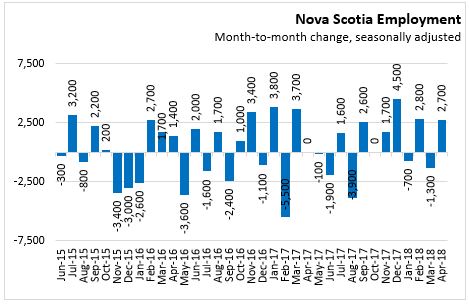
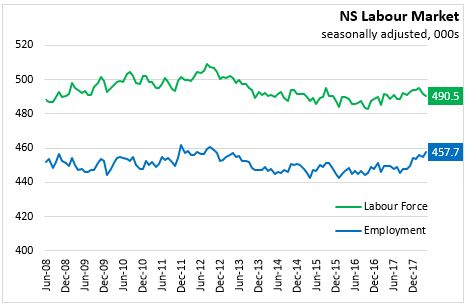

In April, the increase in employment was distributed across both full-time employment (1,100) and part-time employment with an increase of 1,700. Full time employment is now 376,200 – the highest level on record in the labour force survey.
Changes in part-time and full-time employment can include the net impacts of changing hours of work within the same position.
Year-to Date (January-April 2018 vs. January-April 2017)
Comparing the first four months of 2018 to the same period in 2017, there was an increase of 6,400 (1.4 per cent) in the average employment level. Full time employment was up 10,700 (2.9 per cent) while there were 4,300 fewer part-time jobs (-5.1 per cent).
The labour force was up 3,300 (0.7 per cent) compared to the first four months of 2017. With labour demand increasing at a faster pace, the net result was a drop in the average unemployment rate of 0.6 percentage point to 7.6 per cent. The labour force participation rate decreased slightly by 0.1 percentage points to remain at 61.9 per cent. The employment rate increased to 57.2 per cent.
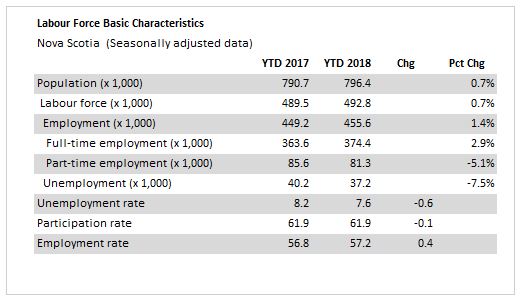
Age Cohorts
Comparing the first four months of 2018 to the same period in 2017, the youth population (aged 15-24) saw a decrease in population (-700) and a drop-in employment (700) while the labour force increased by 900. With labour supply increasing faster than labour demand, the unemployment rate for 15-24 year of age increased from 15.2 per cent in the first four months of 2017 to 17.3 per cent in the first four months of 2018. For April, the youth unemployment rate was 16.4 per cent.
Within the 25-54 age cohort, the population declined 1,100 over the first four months of the year, but saw an employment increase of 5,700 and labour supply increase of 2,700. With employment increasing faster than the labour supply, there was a 1.0 per cent decline in the unemployment rate for this cohort, dropping to 5.8 per cent for the first four months of 2018. The April unemployment rate for core aged workers was 5.0 per cent
The cohort aged 55 and older saw a population increase of 7,400 over the first four months of last year, a labour force decrease of 200 and employment gains of 1,400. With labour demand growing faster than the labour supply, there was a decrease in the unemployment rate to 6.3 per cent (compared to 7.7 per cent over the first four months of 2017). The April unemployment rate for older workers was 5.3 per cent.
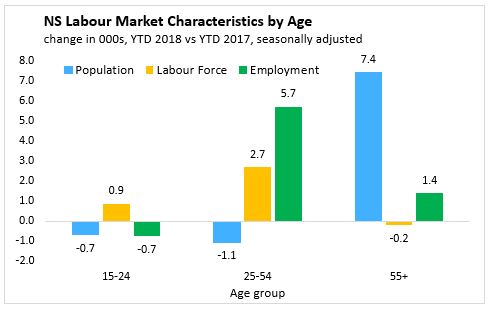

Sectors
Looking at public and private sector employees for the first four months of 2018, the employment increase in private sector employees (6,900) was the driving force offsetting decreases in public sector employees (-2,200). For the same period self-employment was up 1,600.
Among goods-producing sectors, the first four months of 2018 saw employment growth concentrated in manufacturing (+2,800) and construction (+1,300) offsetting declines in forestry, fishing, hunting, mining and oil and gas (-1,700). Services-producing employment increased by 3,100 for the first four months over the same period in 2017. The largest increases come from education services and food and accommodation sectors. The largest decline came from health care and social assistance.
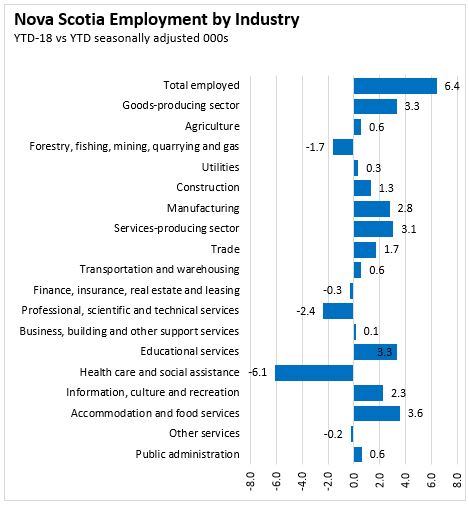
Regions (3 month moving average, January-April 2018 vs. January-April 2017)
Comparing the 3-month average for the first four months of 2018 with the same period in 2017, Halifax was the only region reporting a falling unemployment rate due to employment growth outpacing labour supply. Cape Breton and the South shore regions had lower unemployment rates due labour supply declining at a faster pace than labour demand The North Shore region had falling employment and labour supply causing upward pressure on their unemployment rates. Slower employment growth than labour supply resulted in a higher unemployment rate for the Valley.
The Cape Breton region reported a 600 job decrease with 400 less in the labour force for the first four months of 2018 over the same period in 2017. The net result was a 0.1 percentage point decrease in the unemployment rate to 15.2 per cent.
For the North Shore region, employment decreased 2,600 for the first four months of 2018 compared to the same period in 2017 while the labour force declined 2,500. The faster decline for employment relative to labour supply resulted in an increase to the unemployment rate to 9.6 per cent.
The Annapolis Valley reported an increase in employment of 3,000 and an increase in the labour force of 3,500 for the year-to-date comparison. The net result was an increase of 0.2 percentage points in the average unemployment rate to 9.0 per cent
The Southern region saw a decrease of 300 in employment along with a drop of 1,700 in the labour force. With the labour force falling at a faster pace, the unemployment rate was down 2.4 percentage points to 8.6 per cent compared to the first four months of 2017.
Comparing the first four months of 2018 to the first four months of 2017 estimates, Halifax (HRM) experienced an increase in employment of 6,600 (along with an increase in the labour force of 6,300). With the labour demand growing faster than labour supply the unemployment rate dropped by 0.2 percentage point to 6.5 per cent in Halifax.
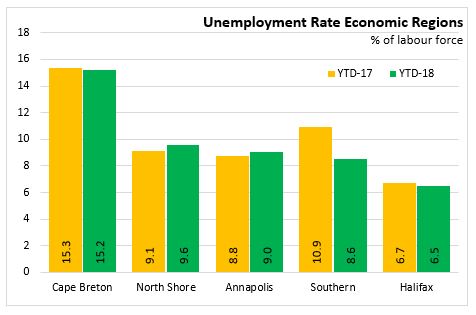
Provincial Comparisons
The Nova Scotia unemployment rate was 6.7 per cent in April 2018. In April of last year, the unemployment rate was 8.4 per cent in Nova Scotia. The Canadian unemployment rate was 5.8 per cent, down from 6.4 per cent one year ago. Compared to the same month one year ago, only Newfoundland and Labrador, PEI, and Manitoba reported a higher unemployment rate. Nova Scotia had the steepest decline (1.7 percentage points). The lowest unemployment rate among the provinces in April 2018 was in British Columbia (5.0 per cent) while the highest was in Newfoundland and Labrador at 14.5 per cent.
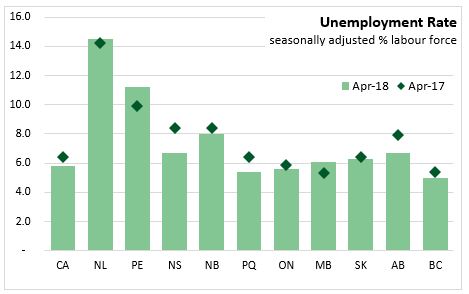
Comparing January-April 2018 with January-April 2017, employment increased 1.6 per cent in Canada. Employment grew in eight of the ten provinces, with the largest gains in Prince Edward Island (+3.0 per cent). Employment declined in Newfoundland and Labrador (-1.0 per cent) and Saskatchewan (-0.4 per cent).
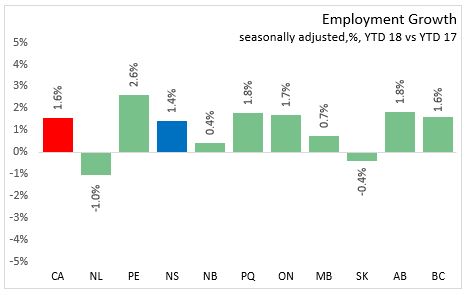
National Comparisons: Cities
The seasonally adjusted unemployment rate for the Halifax Census Metropolitan Area (CMA) in April was 5.6 per cent. Quebec (3.7 per cent) had the lowest unemployment rate among CMAs in April, while the highest was in St. John's (8.6 per cent).
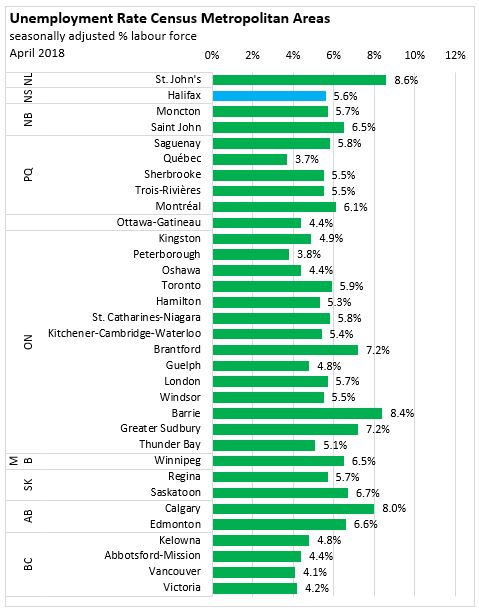
The seasonally adjusted employment rate for the Halifax CMA was 64.6 per cent, up from 64.0 last month. Trois-Rivieres had the lowest employment rates (55.2 per cent), while Calgary had the highest (68.1 per cent).
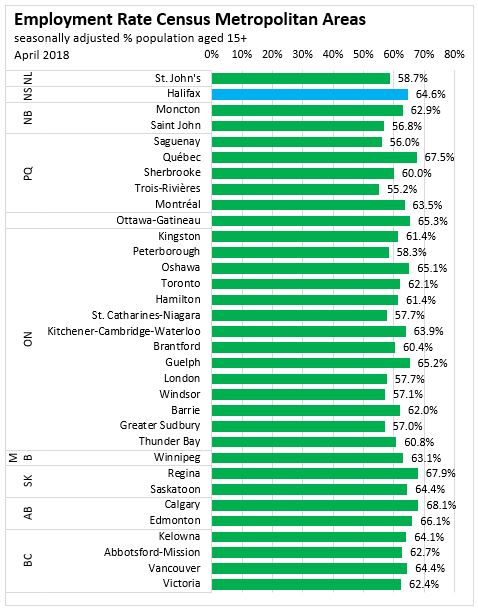
The three month average employment ending in April for the Halifax CMA was up 1.1 per cent compared to the three month period ending in March. The largest gain among CMAs was in Oshawa, ON where employment rose by 2.6 per cent.


Note: Seasonally adjusted, 3 month average.
<--- Return to Archive